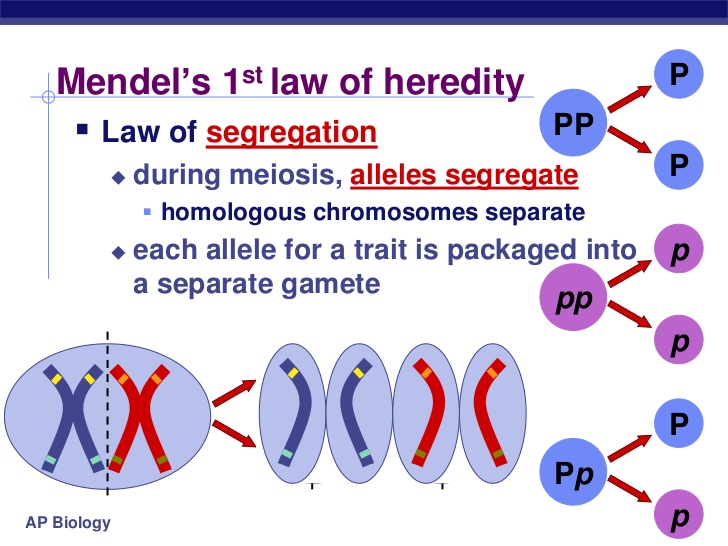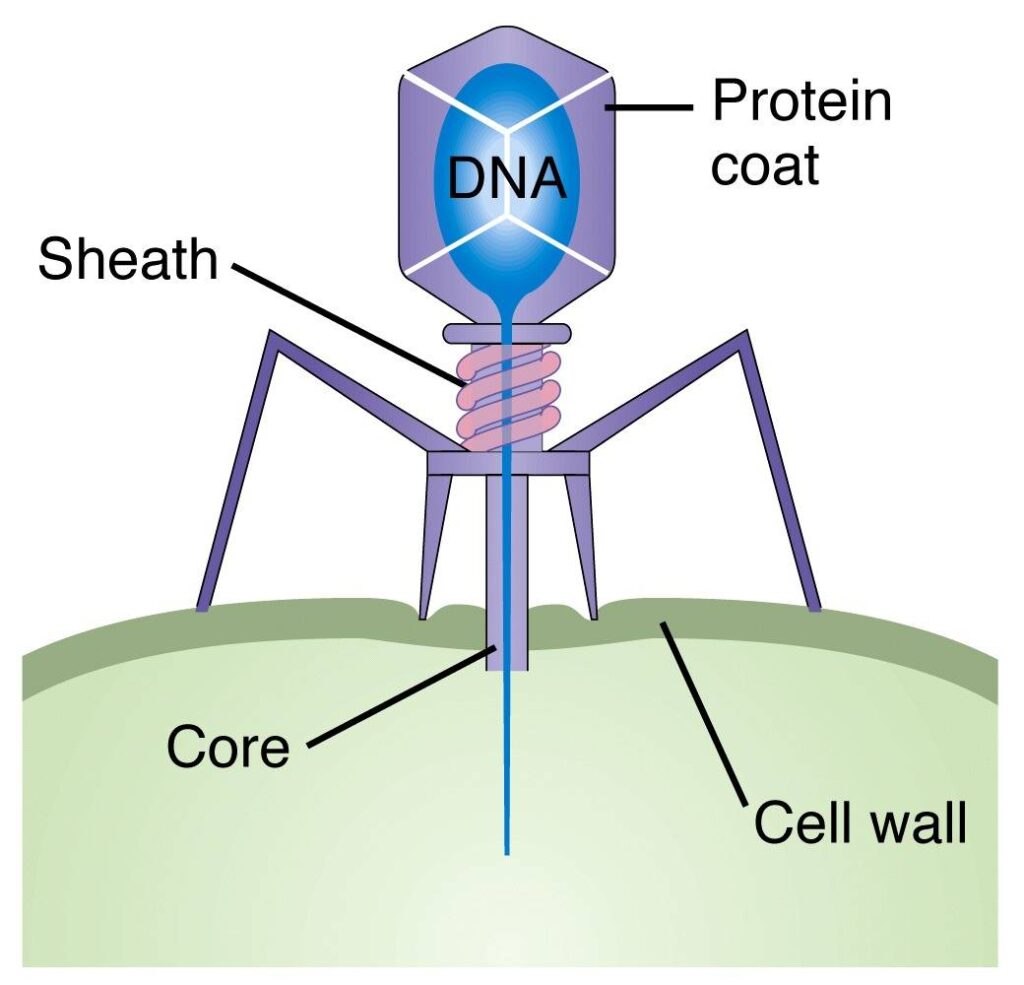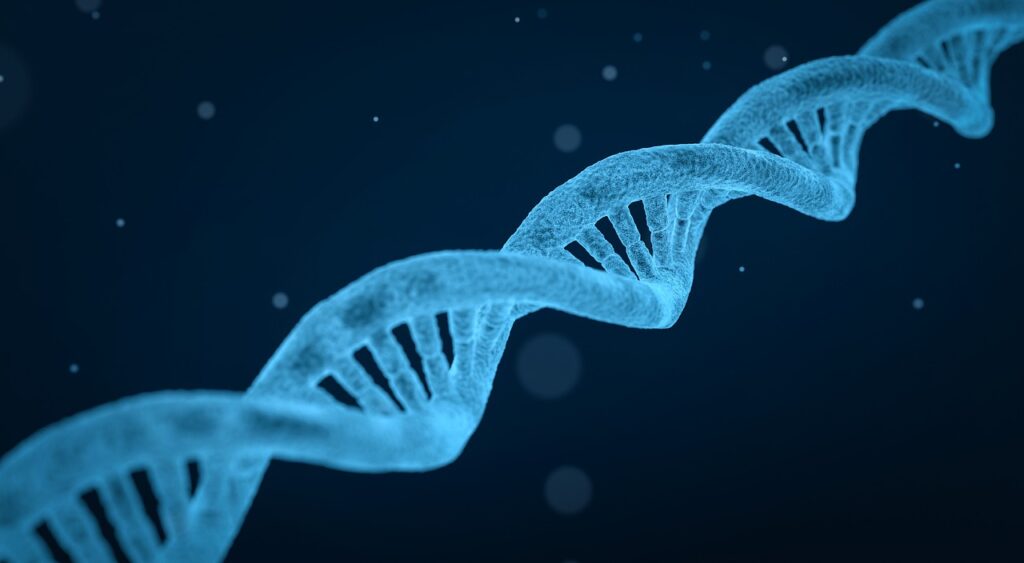The Hershey-Chase experiments were a series of landmark experiments in the development of biology as we know it. They helped establish the nature of genetic matter.
As a result, we now have a much better understanding of how genetics work and the fundamental processes involved.
Index
Background
Reproduction, and hence inheritance, is a core process of biology. Prominent biologists such as Charles Darwin, Gregor Mendel, and Alfred Wallace had discussed the visible effects of these in the nineteenth century itself. But the molecular roots were not understood yet.
Biologists were becoming familiar with many chemicals, called biomolecules, that were found in living organisms. The chief categories of these were proteins, lipids, nucleic acids, and carbohydrates.
The questions that lay ahead of biologists now was this: which of these biomolecules was responsible for the processes of inheritance? In other words, what was the genetic material, the material found in genes that are passed on from the parent organism to its offspring?
As scientists searched for solutions at the sub-cellular level, they noticed something interesting. Chromosomes, parts of the cell found in the nucleus, behaved in a manner that suggested that they could hold the key to the identity genetic material. They showed characteristics such as random segregation and being passed on from parent cell to offspring cell.
These were the very qualities that were required for genetic material, from the modern understanding of Mendel’s theories of inheritance.

Now it was known that chromosomes consisted of two biomolecules – proteins and nucleic acids such as DNA. Which of these two was the actual genetic material?
Many scientists thought that proteins were the right choice. They certainly looked like the stronger candidate. The building blocks of proteins, amino acids, were 20 in number. In comparison, the building blocks of nucleic acids, nucleotides, were only 4. Surely processes as complex as inheritance and genetics depended on the material with more building blocks?
Another reason proteins were favored was because of their versatility. They were known to have many functions and hence structures. On the other hand, nucleic acids were largely inert, and their structure, though unknown, was assumed to be too simple to be of any use in carrying genetic information.
The Avery-MacLeod-McCarty experiment, published in 1944, cast doubt on this. With their experimentation on pathogenic bacteria, they provided evidence to a good degree of certainty that DNA was the actual genetic material. However, most of the scientific community then was firmly in the protein camp, and hence the results did not gain the traction they should have.
It was in this background that the Hershey-Chase experiment took place in 1952.
The Experiment
Prerequisites
Hershey-Chase experiment focussed on the infection of bacteria with the bacteriophage T2. Bacteriophages, often called phages, are viruses that infect bacteria to maintain their life cycle. Crucially for this experiment, phages consist of only two materials: a protein shell outside and DNA inside.
The experiment aimed to distinguish which of these two was the genetic material. The technique used by the experimenters was radioactive labelling.

What is radioactive labelling?
It is a procedure wherein some known atoms are replaced by their radioactive isotopes. These replaced atoms emit radioactivity and hence work as labels to mark the molecule of interest.
For an analogy, think of recolouring pens. A company X manufactures only black pens, which have black bodies too. However, for some bizarre reason, they want to find out what is the writing material of the pen – the ink or the body. So, they do two kinds of modifications. In one, they make the pen body orange, but the ink is still black. In another case, they make the ink orange, but keep the pen body black.
How does this relate to the Hershey-Chase experiment? Think of the pen body as the protein shell and the ink as the DNA. The radioactively labelled versions correspond to the cases where the ink/body color was changed.
This helped successfully distinguish between DNA and proteins because of differences in their chemical composition. Proteins were labelled with radioactive sulphur, 35S in place of regular sulphur, 32S. This labelled only the protein coat and not the DNA because sulphur is not found in any nucleic acid that makes up DNA.
Similarly, radioactive phosphorus 32P was used in place of regular phosphorus 31P to label DNA. Exactly opposite to the case of radioactive sulphur, this labelled only DNA and not protein coat because phosphorus is abundant in DNA but is not a constituent of any amino acid (building blocks of proteins).
The Process
As described before, two kinds of radioactively labelled bacteriophages were obtained – one with radioactively labelled protein shells and one with radioactively labelled DNA. Further, both kinds were grown separately, for several generations, in the required radioactive medium, so all offspring were correctly radioactively labelled.
Now for the actual experiment, two unlabelled bacterial cultures were taken. The two kinds of radiolabelled T2 phages were allowed to separately infect bacteria, in different containers.
Thus, one culture – let us call it A – of bacteria was infected only by the phages whose protein coats were labelled.
The other bacterial culture, called B for clarity, was infected only by the phages whose DNA was radiolabelled.

Next, both cultures were given some time for the infection to spread and then were centrifuged. Because of being centrifuged, the cultures got separated into two parts: a liquid supernatant that floated above, and a solid pellet consisting of the bacterial cells that settled down.
The expectation was that whichever the genetic material was (DNA or protein), it must be found inside the bacterial cells, and thus inside the pellet. This could be identified by testing for radioactivity because both the proteins and the DNA were separately radiolabelled.
Possible Outcomes
There are two possible outcomes:
- CASE 1: If protein was the genetic material, the culture A containing radioactive sulphur would show that the 35S was found in the pellet. Furthermore, analysis of the culture B containing radioactive phosphorus would show that the 32P would be present outside the cells, in the supernatant.
- CASE 2: If DNA was the genetic material, the culture B containing radioactive phosphorus would have 32P found in the pellet. Also, culture A containing radioactive sulphur would show that 35S was found in the supernatant.
Results
The results showed that case 2 was what happened in reality. The labelled phosphorus (and hence DNA) stayed in the infected bacterial cells. The labelled sulphur, thus protein, was left outside the infected cells.
If we use the pen analogy, the paper was provided to be written on by the two kinds of modified pens. The pens with black bodies but orange ink left orange marks on the paper. On the other hand, the pens with orange bodies but black ink showed the same black stains. This confirms that ink, and not the body, is the writing material of the pen.
Similarly, the experiment confirmed that the genetic material of cells was DNA and not protein.
Future Impact
The Hershey-Chase experiment lent strong support to the previously dismissed claim of DNA being the genetic material. The experimenters themselves did not positively confirm that DNA was the genetic material, but clearly excluded proteins from the running. Evidence from scientists such as Chargaff discounted previous claims that DNA was too simple in structure to serve as genetic material.
The final step in this journey was made by the famous James Watson and Francis Crick in 1953 when they presented their theory of DNA structure and replication.
With this, it became part of the fundamentals of biology that genetic information was carried by nucleic acids, DNA in most cases, and RNA in a few.
This opened up many paths in molecular biology. Now scientists could observe how traits were passed on from parent to offspring at the smallest level. They could study how the structure of this genetic material, DNA, helped in the storage of information. Further, they could understand in greater detail how the cell is run by the nucleus via commands encoded in DNA. In fact, the entire collection of DNA of an organism – its genome – became its fingerprint. The possibility of editing DNA and thus tweaking with the very code of life – genome editing – became real.
Today’s world owes much of its understanding of DNA and how it serves as a genetic information carrier to the Hershey-Chase experiment, which set us on the right track and paved the way for groundbreaking discoveries.
FAQ
The experiment basically showed that when bacteriophages, which are composed of DNA and protein, infect bacteria, their DNA enters the host bacterial cell, but most of their protein does not. These experiments combined with subsequent outcomes proved that DNA is our hereditary material.
The experiments were landmark in the development of biology as we know it. They helped establish the nature of genetic matter.
Hershey and chase use radioactive sulfur and phosphorus to mark the molecules of interest. As these radioactive elements emit radioactivity, they can be traced. Radioactive sulfur was used to mark proteins as DNA doesn’t have sulfur. Radioactive phosphorus was used to mark DNA as proteins doesn’t have phosphorus.

